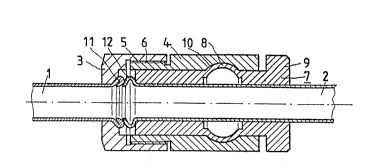Note : Les revendications sont présentées dans la langue officielle dans laquelle elles ont été soumises.
8.
CLAIMS
1. Tube connection for thin-walled, small calibre
metal tubes, at least one of the metal tubes being
provided on the end to be connected with a flange and
the metal tubes being enveloped by a sleeve in each
case, of which at least one can be deformed by the
effect of a contact pressure on the sleeves and thus on
the flange so as to form a connection between the
sleeves, characterised in that at least one of the
sleeves (3, 4; 21, 22; 25, 28) consists of a part (4,
22, 28) which can be connected to the other sleeve (7,
29) by deformation and a part (3, 21, 25) which
envelopes the metal tube (1) and in that a releasable
connection (5, 6) is provided between the parts.
2. Tube connection according to claim 1,
characterised in that the releasable connection
comprises a screw connection (5, 6).
3. Tube connection according to claim 1,
characterised in that both metal tubes are in each case
provided with a flange ( 11, 12).
4. Tube connection according to claim 1,
characterised in that one of the tubes is formed from
one of the sleeves or from a part of one of the sleeves
(Figure 5, 7).
5. Tube connection according to claim 2,
characterised in that in a manner known in itself a
first sleeve (3, 4; 21, 22; 25, 28) is provided with a
larger inside diameter in an area jutting out over the
end of the first metal tube (1) enveloped by the first
sleeve (3, 4; 21, 22; 25, 28), this inside diameter
being suitable for receiving a second sleeve
constructed as a partially thin-walled press bush (7,
29), in that an annular channel (10) which extends
around the inner wall of the first sleeve (3, 4; 21,
9.
22; 25, 28) is opposite the thin-walled part (8) of the
press bush (7, 29), in that the thin-walled part (8) of
the press bush (7, 29) can be sufficiently deformed
into the annular channel (10) by means of the contact
pressure and in that the first sleeve consists of two
parts (3, 4; 21, 22; 25, 28) which are connected by a
screw connection.
6. Tube connection according to claim 5,
characterised in that the screw connection (5, 6) in
the area of the larger inside diameter of the sleeve
(3, 4) is provided in such a way that both parts (3, 4)
of the sleeve have in each case a surface which is
accessible from the outside.
7. Tube connection according to claim 6,
characterised in that the parts (3, 4) of the first
sleeve have on the outside a hexagonal configuration.
8. Tube connection according to claim 5,
characterised in that a first part (21, 25) of the
first sleeve which envelops the first metal tube (1) is
provided at the periphery with an external thread, in
that a second part (22, 28) of the first sleeve
essentially envelops the first part (21, 25) and is
provided with an internal thread and in that the first
part contains recesses (23, 24) for inserting a key on
the end face remote from the flange of the first metal
tube (1).
9. Tube connection according to claim 8,
characterised in that the first part (25) is provided
with a circumferential flange (26) which is adapted to
be received in a circumferential recess (27) in the
second part (28).
10. Tube connection according to claim 5,
characterised in that the press bush (7, 29) is
provided with a flange at the end (9) projecting from
the first sleeve (3, 4; 21, 22; 25, 28).
10.
11. Tube connection according to claim 3,
characterised in that a connection tube (31) of a unit
is provided with an external thread which engages in an
internal thread of a first sleeve (33) which juts out
over the connection tube (31) and which has an inside
diameter t for receiving a second sleeve which is
constructed as a partially thin-walled press bush (29),
in that an annular channel which extends around the
internal wall of the first sleeve (33) is opposite the
thin-walled part of the press bush (29) and in that the
thin-walled part of the press bush (29) can be deformed
into the annular channel by means of the contact
pressure.
12. Tube connection according to claim 4,
characterised in that in a manner known in itself a
first sleeve (3, 4) has a larger inside diameter in an
area jutting out over the end of the first metal tube
(1) enveloped by the first sleeve (3, 4), this inside
diameter being suitable for receiving a second sleeve
constructed as a partially thin-walled press bush, in
that an annular channel which extends around the
internal wall of the first sleeve (3, 4) is opposite
the thin-walled part of the press bush, in that the
thin-walled part of the press bush can be deformed into
the annular channel by means of the contact pressure,
in that the first sleeve (3, 4) consists of two parts
(3, 4) which are connected by a screw connection and in
that the second sleeve forms a connection tube of a
unit.
13. Tube connection according to claim 12,
characterised in that the second sleeve is provided
with a flange (41) which forms a set surface for a
pressing tool.
